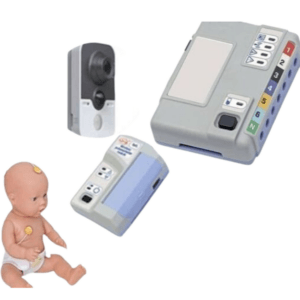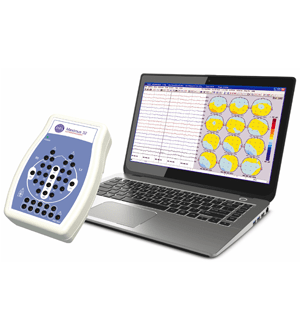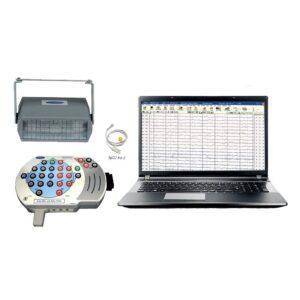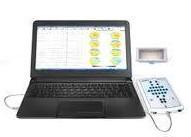The subject of neuroscience has seen a revolution because to electroencephalograph systems (EEG), which have also created fresh perspectives on how the brain functions. The non-invasive EEG approach examines the electrical activity of the brain using electrodes placed on the scalp. It captures the voltage swings brought on by the brain’s neurons firing. The resultant brainwave patterns can shed light on cognitive processes, neurological illnesses, and brain function.
Modern EEG devices offer precise and thorough brain monitoring.
They offer advanced features such as high-density arrays, simultaneous multi-modal recording, and real-time processing. These machines have applications in medical settings such as epilepsy monitoring units, intensive care units, and operating rooms. They have also been used in research studies to investigate brain function and cognitive processes.
Types of Electroencephalograph Systems (EEG)
Portable Electroencephalograph Systems (EEG)
These devices offer flexibility and convenience in ambulatory monitoring, research studies, and remote diagnostics. They can be worn on the head like a cap and provide continuous monitoring of brain activity. They are particularly useful in assessing brain function in real-world environments and during activities such as sports, driving, and gaming. Portable EEG devices have also been used in research studies to investigate cognitive processes in naturalistic settings.
Wireless Electroencephalograph Systems (EEG)
These systems offer freedom of movement and enhanced mobility. They can be used in clinical settings, research studies, and neurofeedback applications. They eliminate the need for cumbersome wires and allow for more natural movement during brain monitoring. Wireless EEG systems have also been used in research studies to investigate brain function and cognitive processes during naturalistic activities.
Clinical Electroencephalograph Systems (EEG)
It is a diagnostic tool for brain disorders such as epilepsy, sleep disorders, and neurological conditions. It can tell you where, what kind, and how severe aberrant brain activity is. Additionally, it is employed in patient management and treatment planning. The effectiveness of therapy for epilepsy and other neurological illnesses has been studied using clinical EEG.
Neurofeedback training using EEG technology can optimize brain function and enhance performance. It involves providing feedback on brainwave patterns and training individuals to regulate their brain activity. It has applications in cognitive training, attention disorders, stress reduction, and peak mental performance. Neurofeedback training has been used to investigate the efficacy of treatments for attention disorders and stress reduction.
EEG is utilized in sleep studies to assess sleep stages, identify sleep disorders, and evaluate sleep patterns. It can help in diagnosing disorders like sleep apnea, insomnia, and parasomnias as well as provide light on the significance of sleep architecture. The effectiveness of sleep problem therapies and the impact of sleep deprivation on cognitive functions have both been studied using EEG.
Advanced EEG data analysis software can process and interpret brainwave patterns. These tools assist researchers in analyzing brain activity, identifying abnormalities, and extracting valuable insights for neuroscience studies. The neural correlates of cognitive processes and the impact of brain stimulation on brain function have both been studied using EEG data analysis tools.
Advances in EEG Technology: Pushing the Boundaries of Brain Monitoring
Electroencephalograph Systems (EEG) have advanced significantly throughout time, revolutionizing the study and monitoring of the brain. These developments have made it possible for academics and medical professionals to learn more about the intricate workings of the brain and get insightful knowledge. The astonishing advancements in EEG technology that have pushed the limits of brain monitoring and deepened our understanding of the human mind will be discussed in this section.
High-density Electroencephalograph Systems (EEG)
Traditional EEG systems used a limited number of electrodes to measure brain activity. However, with the advent of high-density EEG, researchers can now capture brain signals with a much higher spatial resolution. This allows for more precise localization of brain activity, making it possible to identify subtle changes and understand the intricate networks within the brain.
Wireless Electroencephalograph Systems (EEG)
The introduction of wireless EEG systems has brought about a paradigm shift in brain monitoring. Gone are the days of cumbersome wires and restricted movement. Wireless EEG systems utilize advanced technologies such as Bluetooth and Wi-Fi to transmit data without the need for physical connections. This enhanced mobility and freedom of movement have opened up new possibilities for ambulatory monitoring, real-world applications, and remote diagnostics.
Miniaturization and Portability
Advancements in technology have led to the development of compact and portable EEG devices. These portable EEG systems offer convenience and ease of use, allowing for on-the-go brain monitoring. Researchers can now conduct EEG assessments outside the confines of a lab, enabling studies in naturalistic settings and enhancing the ecological validity of the data.
Advanced Signal Processing
The ability to extract meaningful information from EEG signals is crucial for accurate interpretation. Advances in signal processing techniques have enabled researchers to analyze EEG data more effectively. Sophisticated algorithms and machine learning approaches can now detect and classify specific brain patterns, facilitating the identification of abnormal activity and providing valuable insights into brain function.
Real-time Data Analysis
Real-time data analysis is a significant advancement in EEG technology. Previously, EEG data would be collected and analyzed offline. However, with the integration of powerful processors and software, EEG systems can now provide real-time analysis, enabling immediate feedback and intervention. This has proven to be highly beneficial in the training process for neurofeedback, which teaches people how to control their brain activity in real-time.
Multimodal Integration
Multimodal Integration: EEG is commonly combined with other imaging techniques like functional magnetic resonance imaging (fMRI) or positron emission tomography (PET) to offer a more comprehensive understanding of brain activity. This multimodal integration allows researchers to correlate EEG findings with anatomical and metabolic information, resulting in a more holistic picture of brain function.
Improved Accessibility and Affordability
As technology advances, EEG systems have become more accessible and affordable. This has broadened the scope of EEG research and enabled healthcare providers in various settings to incorporate EEG into their diagnostic and treatment protocols.
EEG-based Brain-Computer Interfaces (BCIs)
They have the potential to assist individuals with communication and control. They translate brainwave patterns into commands that can control external devices such as prosthetics and wheelchairs. They have applications in neurorehabilitation and assistive technology. Brain stimulation’s effects on brain function and the effectiveness of treatments for neurological illnesses have both been studied using EEG-based BCIs.
Our understanding of brain function, cognitive functions, and neurological illnesses has greatly benefited from EEG investigations. They have offered insights into a variety of disciplines, including neurology, neurofeedback, and psychology.
EEG studies have been used to investigate the neural correlates of cognitive processes and to investigate the effects of brain stimulation on brain function.
Advantages of Electroencephalograph Systems (EEG) include
- Non-invasive: Non-invasive: The scalp is covered with electrodes during an EEG, making it a painless and secure procedure for patients.
- High Temporal Resolution: EEG has excellent temporal resolution, meaning it can measure brain activity in real-time with millisecond precision. This allows for the detection of rapid changes and the tracking of dynamic brain processes.
- Cost-Effective: Compared to other neuroimaging techniques like fMRI or PET scans, EEG is relatively more affordable and accessible. It can be performed in standard medical settings and does not require expensive equipment or infrastructure.
- Wide Range of Applications: EEG has a myriad of uses in both clinical and scientific contexts.It is used to diagnose and keep track of a variety of neurological illnesses, epilepsy, sleep difficulties, and other brain disorders.EEG is also used in sleep research, brain-computer interfaces, neurofeedback, and cognitive neuroscience.
- Functional Insights: EEG provides valuable insights into brain function by measuring electrical activity directly from the brain. Researchers and doctors can better understand brain functions and associated anomalies thanks to the information it can provide on brain rhythms, connectivity between brain regions, and event-related potentials.
- Portable and Ambulatory Monitoring: The development of portable EEG devices has made it possible to monitor brain activity outside the traditional laboratory setting. This portability enables ambulatory monitoring, allowing for the assessment of brain activity in natural environments, during daily activities, or during sleep.
- Safe for Different Populations: EEG is secure for people of all ages, including newborns, kids, adults, and the elderly. It is a flexible tool for both clinical practise and neuroscience research since it may be used to examine brain function across the lifespan and in different clinical populations.
- Complementary Technique: EEG can be combined with other neuroimaging techniques like fMRI or PET to provide complementary information about brain function. Overall, EEG offers a powerful and versatile tool for studying brain function, diagnosing brain disorders, and monitoring treatment responses.It is a crucial technique in the study of neuroscience and clinical neurology because of its non-invasiveness, real-time measurement capabilities, and variety of applications.
Electroencephalograph Systems (EEG) from Leading Manufacturers
Encephalan-CFM Cerebral Function Monitor
 The Encephalan-CFM Cerebral Function Monitor, manufactured by VNG Medical Innovation System Pvt. Ltd., is a cutting-edge cerebral function monitor that provides accurate brain activity monitoring and assessments in various clinical settings. Designed specifically for neonatal brain monitoring, this device allows clinicians to track brain activity and facilitate the diagnostic process. Unlike short-term EEG studies, Encephalan-CFM offers continuous monitoring and displays brain activity through amplitude-integrated EEG trends and other quantitative parameters. Its continuous analysis capability is invaluable for the diagnosis and screening of various conditions, including perinatal asphyxia, associated brain damage, epileptiform activity, and low cerebral perfusion. It helps identify and differentiate EEG patterns, aiding in the diagnosis of hypoxic-ischemic disorders, seizure activity, functional areas of the cerebrum, and predicting neurological outcomes.
The Encephalan-CFM Cerebral Function Monitor, manufactured by VNG Medical Innovation System Pvt. Ltd., is a cutting-edge cerebral function monitor that provides accurate brain activity monitoring and assessments in various clinical settings. Designed specifically for neonatal brain monitoring, this device allows clinicians to track brain activity and facilitate the diagnostic process. Unlike short-term EEG studies, Encephalan-CFM offers continuous monitoring and displays brain activity through amplitude-integrated EEG trends and other quantitative parameters. Its continuous analysis capability is invaluable for the diagnosis and screening of various conditions, including perinatal asphyxia, associated brain damage, epileptiform activity, and low cerebral perfusion. It helps identify and differentiate EEG patterns, aiding in the diagnosis of hypoxic-ischemic disorders, seizure activity, functional areas of the cerebrum, and predicting neurological outcomes.
With three application modes—telemetric, autonomous, and autonomous-telemetric—Encephalan-CFM provides comprehensive monitoring options. It is available in portable and mobile versions, allowing for convenient use in different clinical scenarios. The sales package includes essential components for comprehensive monitoring and data acquisition, ensuring healthcare professionals can accurately assess brain function and make informed treatment decisions.
Maximus 24
 Recorders & Medicare Systems Pvt. Ltd. (RMS India), a leading manufacturer of EEG machines, offers the Maximus 24—a state-of-the-art 24-channel EEG machine. Powered by USB, this machine is suitable for use in various settings, including ICU, operating theaters, bedside recording, and even at patients’ residences. The Maximus 24 provides flexibility in data transfer with the ability to email or transfer reports across a network. Its user-friendly interface makes it easy to operate, making it an ideal choice for EEG monitoring.
Recorders & Medicare Systems Pvt. Ltd. (RMS India), a leading manufacturer of EEG machines, offers the Maximus 24—a state-of-the-art 24-channel EEG machine. Powered by USB, this machine is suitable for use in various settings, including ICU, operating theaters, bedside recording, and even at patients’ residences. The Maximus 24 provides flexibility in data transfer with the ability to email or transfer reports across a network. Its user-friendly interface makes it easy to operate, making it an ideal choice for EEG monitoring.
BrainTech 24+
 Clarity Medical Pvt. Ltd. is a renowned manufacturer and global supplier of electroencephalograph systems (EEG). Their BrainTech 24+ is a portable and low-power EEG machine with 24 channels. Designed to work in conjunction with a laptop or desktop computer, it operates entirely via USB power. The BrainTech 24+ offers online and offline reformatting of gain, filter, and sweep speed, providing flexibility and customization options for users. Equipped with high-intensity white LED EEG flash with a built-in rechargeable Li-ion battery, it ensures reliable and efficient EEG recordings. The highly advanced database management system with multiple search options simplifies data organization and retrieval. Additional features include integrated SpO2 technology (upon request) and an optional HD video camera for enhanced monitoring capabilities.
Clarity Medical Pvt. Ltd. is a renowned manufacturer and global supplier of electroencephalograph systems (EEG). Their BrainTech 24+ is a portable and low-power EEG machine with 24 channels. Designed to work in conjunction with a laptop or desktop computer, it operates entirely via USB power. The BrainTech 24+ offers online and offline reformatting of gain, filter, and sweep speed, providing flexibility and customization options for users. Equipped with high-intensity white LED EEG flash with a built-in rechargeable Li-ion battery, it ensures reliable and efficient EEG recordings. The highly advanced database management system with multiple search options simplifies data organization and retrieval. Additional features include integrated SpO2 technology (upon request) and an optional HD video camera for enhanced monitoring capabilities.
Virgo

Allengers Medical Systems Ltd. presents the Virgo series of EEG test systems, offering advanced brain mapping and digital signal processing technology. These devices collect, store, and transport biophysical characteristics to EEG machines, aiding in the diagnosis of neurological and sleep disorders. The Virgo series enables clinicians to measure and visualize cerebral activities for EEG and Sleep Studies. With this valuable information, healthcare professionals can diagnose sleep illnesses, epilepsies, and similar disorders.
The Virgo series features a plug-and-play USB interface, making it portable without the need for external power supply. Its lightweight and compact amplifier, along with high-quality electrodes, ensures comfort and accuracy during EEG recordings. The system also offers features such as Amplitude Integrated EEG (AEEG), CSA/DSA frequency distribution, brain mapping, and user-editable montages. It provides the convenience of sending EEG data through email and exporting it in various formats, including MATLAB, LabView, and media player formats.
Medzell: Promoting Medical Devices in Emerging Markets
Medzell is a futuristic B2B platform that promotes medical devices in emerging markets. It connects manufacturers with buyers and provides a seamless platform for business transactions.
Conclusion
In conclusion, Electroencephalograph Systems (EEG) have revolutionized brain monitoring and analysis. With advancements in EEG machines, portable EEG devices, wireless EEG systems, and EEG data analysis software, the potential of EEG is limitless. And with platforms such as Medzell promoting medical devices in emerging markets, the future of EEG is bright.


